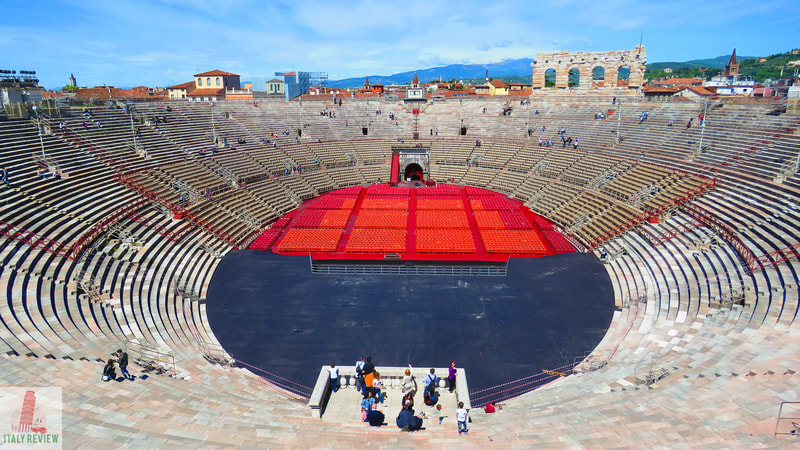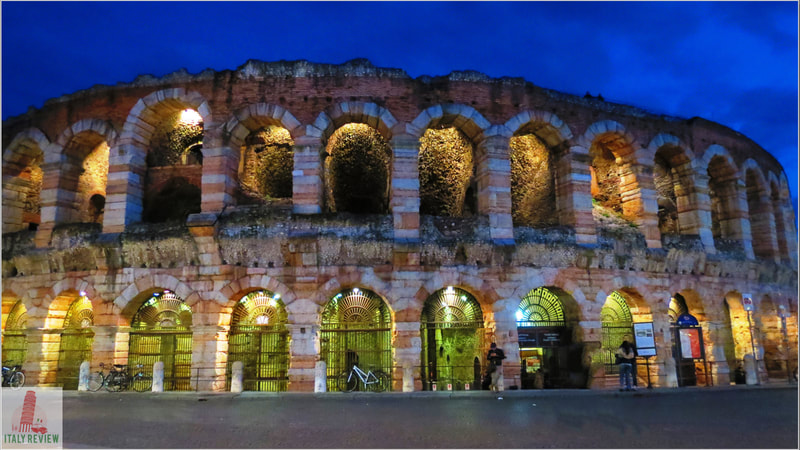Verona Arena
|
By Dion Protani
|
Latest update: 21 January 2024
|
|
The Verona Arena was built in 30 AD but still survives to this day as an outdoor concert venue. In ancient times it held as many as 30,000 spectators who came from far and wide to watch a series of games known as ludi, which included chariot and horse races.
In modern times, the Arena on Piazza Bra in the centre of Verona hosts evocative musical concerts during summer evenings. |
Related links
Profile
The Verona Arena, also known as the Arena di Verona, is a magnificent ancient Roman amphitheater located in Verona, Italy. Constructed in the 1st century AD, it is one of the best-preserved and most significant Roman arenas in the world. Originally built for gladiator contests, public spectacles, and theatrical performances, the Arena has stood the test of time and remains an iconic symbol of Verona's rich history and cultural heritage.
Key features
- Overview: The Verona Arena is an awe-inspiring structure that continues to captivate visitors with its grandeur and historical significance. Built entirely of pink-tinged local limestone, the amphitheater stands as a testament to Roman engineering prowess.
- Architecture: The Arena boasts an elliptical shape, measuring approximately 140 meters in length and 110 meters in width. With an impressive height of around 30 meters, it once accommodated up to 30,000 spectators who gathered to witness the grand spectacles of ancient times.
- Tiered Seating: The Arena features multiple tiers of seating, divided into three horizontal sections, each adorned with distinct architectural elements. The lowest section, known as the "podium," was reserved for the Roman elite, while the middle and upper sections were for the general public.
- The Inner Structure: The interior of the Arena is an intricate network of passageways, chambers, and staircases, designed to facilitate smooth access for performers, gladiators, and animals during events.
- Acoustics: Remarkably, the Arena has exceptional acoustics, which enhance the quality of live performances and concerts held within its walls.
Visitor information
- Location: The Verona Arena is situated in Piazza Bra, the main square of Verona, just a short walk from the city's historic center.
- Best Time to Visit: The Arena is open to visitors throughout the year. The best time to visit depends on personal preferences, but attending a live performance during the Verona Opera Festival, held in the summer months, is a truly magical experience.
- Opera Performances: The Arena is famous for hosting world-class opera performances and concerts. The annual Verona Opera Festival, usually held from June to August, attracts music enthusiasts from around the globe.
- Guided Tours: Guided tours of the Arena are available, providing visitors with insights into its fascinating history, architecture, and the various events that have taken place over the centuries.
- Accessibility: The Arena is accessible to visitors with mobility challenges, with ramps and elevators facilitating access to different levels.
- Nearby Attractions: Piazza Bra, with its numerous cafes and restaurants, offers an ideal spot to relax and enjoy the ambiance of the city. Verona's historic center, with attractions like Juliet's House and Piazza delle Erbe, is within walking distance.
- Conservation: The Verona Arena is a protected UNESCO World Heritage Site. It is essential to respect the historical value of the monument and follow guidelines to ensure its preservation for future generations.
Arena di Verona
|
City: Verona
Province: Verona Region: Veneto Built: 30 AD Close by: Piazza Bra, Castelvecchio Bridge, River Adige Recommended accommodation: Hotel Accademia |
UNESCO World Heritage Site
City of Verona
Year: 2000
City of Verona
Year: 2000























